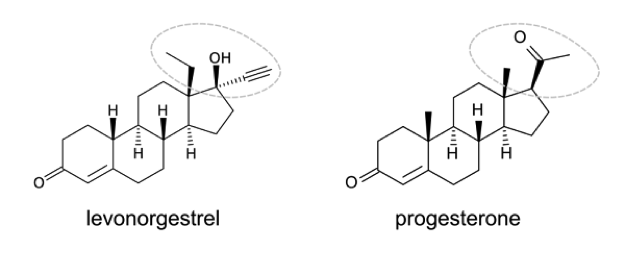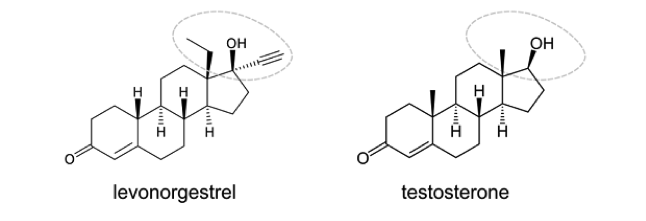Millions of women are offered the hormonal IUD coil for a variety of reasons, either as a form of contraception, to reduce the symptoms of hormone imbalances such as heavy bleeding or as an option for replacing progesterone with Hormone Replacement Therapy (HRT).
When we are asked if the hormonal IUD coil is a good option, our response in a word is… no.
There are several issues associated with the hormonal IUD coil:
- Synthetic vs natural progesterone
The progesterone in most HRT isn’t really progesterone. It’s a synthetic called Progestin.
The image below shows the difference between levonorgestrel, which is the progestin used many oral contraceptives, implants, hormonal IUD coil, and the morning-after pill and natural progesterone.

Chemically these are totally different. Levonorgestrel is more similar to testosterone than progesterone, which is problematic because progesterone is a calming hormone whereas testosterone is an exciter hormone.

This “exciter” hormone means we end up overstimulated and “tired but wired” because we don’t have the biochemistry we need to relax and unwind, leading to disturbed sleep or full-on insomnia.
This “pretend progesterone” issue is also important because of how the hormones affect the body.
Progesterone:
- beneficial for cardiovascular health
- stimulates hair growth
- calms mood and promotes sleep
- prevents breast cancer
Progestin:
- increases the risk of fatal blood clots
- can cause hair loss (due to its similarity to testosterone)
- may cause anxiety and depression
- increases the risk of breast cancer and breast changes
- Contributes to acne
- Contributes to weight gain
- Can cause yeast infections
- Can cause headaches and migraines
The hormonal IUD coil itself comes with the following potential side effects:
- Cramping
- Depression and mood swings
- Fatigue
- Discomfort and pain if the device fails to remain in place
- Increased risk of pelvic inflammatory disease
Even the current guidelines for how doctors are recommended to work with women’s health state that natural (body identical) progesterone carries fewer risks than progestin but that the first offering should be progestin.
- Masking problems, not solving them
Women are offered the hormonal IUD coil when they are struggling with heavy bleeds or issues with their periods, but the hormonal IUD coil partially suppresses ovulation which is not great for a woman’s body. Successful ovulation is a key metric in women’s health and wellbeing, so we don’t want to mess with this process.
Period problems such as heavy or painful bleeds, irregular bleeds, mood swings, acne, PMS, and PMDD are signs of a hormone imbalance and this needs correcting not masking.
- Creating a false ‘negative’ around periods
Many women say they love not having to deal with their bleeds and this can commonly be promoted as a positive. However, we need to push back on this engendered culture of being pleased to get rid of bleeds. Instead it’s incredibly important to acknowledge and embrace the fact that a woman’s ovulatory cycle is a key indicator of her health and whilst we understand that it can be life affecting when hormones are imbalanced and bleeds are challenging, it is more important to fix this properly than mask it.
- Biased prescribing based on profit not health
It has been reported many times that doctors are financially incentivised to give the hormonal IUD coil. All the while this is happening, women are not being offered unbiased advice based on what is best for their health and lifestyles.
- Medical ‘miseducation’
There is a common myth populated by GPs about the mirena coil that the hormones are ‘localised’. This makes no sense if you have even a basic knowledge of physiology as hormones enter the bloodstream and therefore end up being present systemically.
The phrase often used is ‘the hormones stay mainly in the uterus’ but research shows that these progestins do show up in blood tests, therefore we are exposing ourselves to the unnecessary side effects listed previously.
So what do we recommend instead?
There are now multiple options for body identical progesterone and oestrogen available from your healthcare provider and we strongly recommend our HRT Blog for more information.


